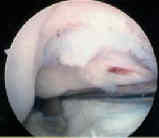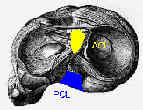- See: Biomechanics of the ACL:

- Discussion:
- length of 38 mm (range 25 to 41 mm)
- width of 10 mm (range 7 to 12 mm)
- made up of multiple collagen fascicles;
- surrounded by an endotendineum
- microspocially: interlacing fibrils (150 to 250 nanomet in diamter
- grouped into fibers (1 to 20 um in diameter)
- synovial membrane envelvope
- innervation:
- receives its innervation from tibal nerve;
- infiltrates the capsule posteriorly;
- golgi tendon receptors;
- references:
- A sensory role for the cruciate ligaments.
- Mechanoreceptors in human cruciate ligaments. A histological study.
- Neural anatomy of the human anterior cruciate ligament.
- Proprioception after rupture of the anterior cruciate ligament. An objective indication of the need for surgery.
- blood supply:
- major blood supply: from middle genicular artery:
- supplied by the middle genicular artery;
- bony attachments do not provide a significant source of blood to distal or proximal ligaments;
- references:
Microvasculature of cruciate ligaments and its response to injury. An experimental study in dogs.

- Femoral and Tibial Attachments:
- femoral attachment:
- ACL arises from the posteromedial corner of medial aspect of lateral femoral condyle in the intercondylar notch;
- attachment is actually an interdigitation of collagen fibers & rigid bone thru transitional zone of
fibrocartilage and mineralized fibrocartilage;
- femoral attachment of ACL is on posterior part of medial surface of lateral condyle well posterior to longitudinal axis of the
femoral shaft;
- tibial attachment:
- tibial attachment is in a fossa in front of & lateral to anterior spine, a rather wide area from 11 mm in width to 17 mm in AP direction;
- anterior fibers go forward to level of transverse meniscal ligament;
- inserts into the interspinous area of the tibia;
- Anterior & Posterior Bundles:
- ACL is composed of two principal parts: small anteromedial band and a larger bukly posterolateral portion;
- anteromedial bundle is tight in flexion and the posterolateral bundle is tight in extension;
- extension: both bundles are parallel;
- flexion:
- femoral insertion site of the posterolateral bundle moves anteriorly
- both bundles are crossed
- anteromedial bundle tightens and posterolateral bundle loosens;
- ref: Functional anatomy of the anterior cruciate ligament. Fibre bundle actions related to ligament replacements and injuries.
- posterolateral bundle:
- represents posterior directly directed fibers w/ its attachment just lateral to midline of the intercondylar eminence and slightly lateral to most lateral
attachement of the intermediate bundle;
- anteromedial portion is tight in flexion whereas the posterolateral bulky portion of ligament is tight in extension (and internal rotation);
- unlike the antermedial portion, the bulkier posterolateral bundle is not isometric.
- interruption of posterolateral bundle of ACL increases external rotation recurvatum test of posterolateral after anteromedial and intermediate
bundles are divided;
- w/ knee extended, resistance to the anterior drawer test is by posterolateral bulky portion;
- it limits anterior translation, hyperextension, and rotation;
- oblique position of the posterolateral bundle provides more rotational control than is provided by the anteromedial bundle, which is in a more axial position;
- hyperextension and internal rotation place the posterolateral bundle at greater risk for injury;
- rupture cause increases in hyperextension, anterior translation (extended knee), increase in external and internal rotation (knee extended),
and increases in external rotation with the knee in mid flexion;
- anteromedial bundle:
- femoral insertion of the anteromedial bundle is the center of rotation of ACL
- anteromedial bundle has isometric behavior;
- anteromedial bundle tightens in flexion while the posterolateral bundle relaxes in flexion.
- is more prone to injury with the knee in flexion
- anteromedial bundle inserts on the medial aspect of the intercondylar eminence of the tibia and forms the medial corner of the triangle;
- anteromedial band is primary check against anterior translation of tibia on femur when anterior drawer test is performed in usual manner w/ knee flexed;
- cutting this ligament may produce anterolateral instability;
- limits anterior translation of the tibia on the femur with the knee in flexion (which requires isometric behavior);
- rupture may cause in an increase in anterior translation in flexion, minimal increase in hyperextension, and minimal rotational instability;
- intermediate bundle:
- cutting this ligament produces straight anterior instability;
- when anteromedial band of the ligament is torn, posterolateral bulk of ligament may remain intact & anterior drawer sign will be present but surgeon will
have impression that ligament is not torn;
- reference:
- Functional anatomy of the anterior cruciate ligament. Fibre bundle actions releated to ligament replacements and injuries.
Functional anatomy of the anterior cruciate ligament and a rationale for reconstruction.
Follow up of the acute nonoperated isolated anterior cruciate ligament tear.
Anatomy of the anterior cruciate ligament.
Anatomy of the Anterior Cruciate Ligament with Regard to Its Two Bundles.



